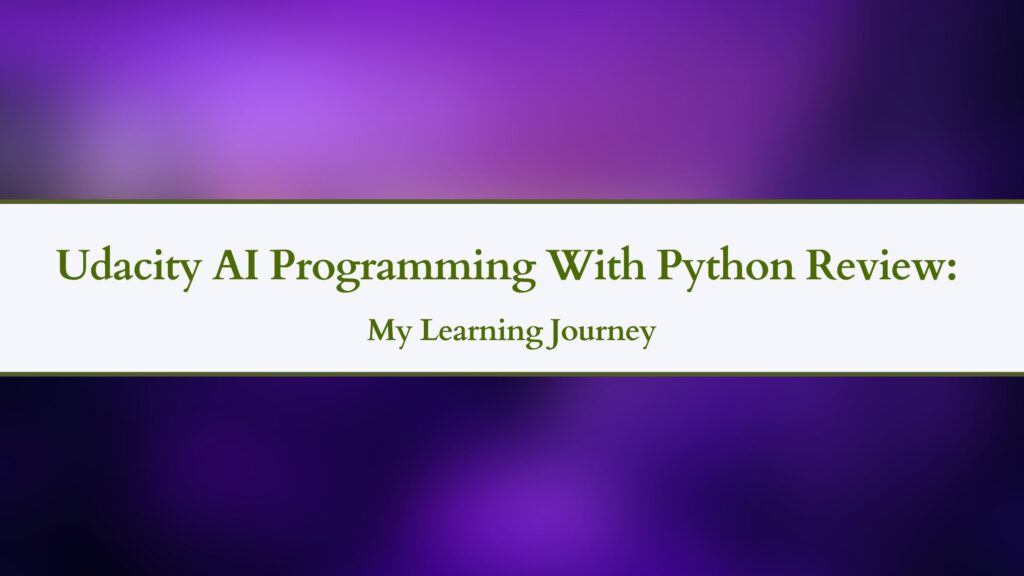Hi everyone! I’m Aqsa Zafar — the founder of MLTUT. If you’re new here, I create content on machine learning and data science to make these topics feel a little less scary and a lot more beginner-friendly. My goal is to help learners around the world understand these complex ideas in a simple and practical way. Today, I want to share something that I personally found really helpful when I was strengthening my AI basics — my detailed Udacity AI Programming With Python Review.
If you’re someone who’s just starting your AI journey and want to build a strong base in Python programming, NumPy, Pandas, linear algebra, and even a bit of neural networks, then this might be the course you’re looking for.
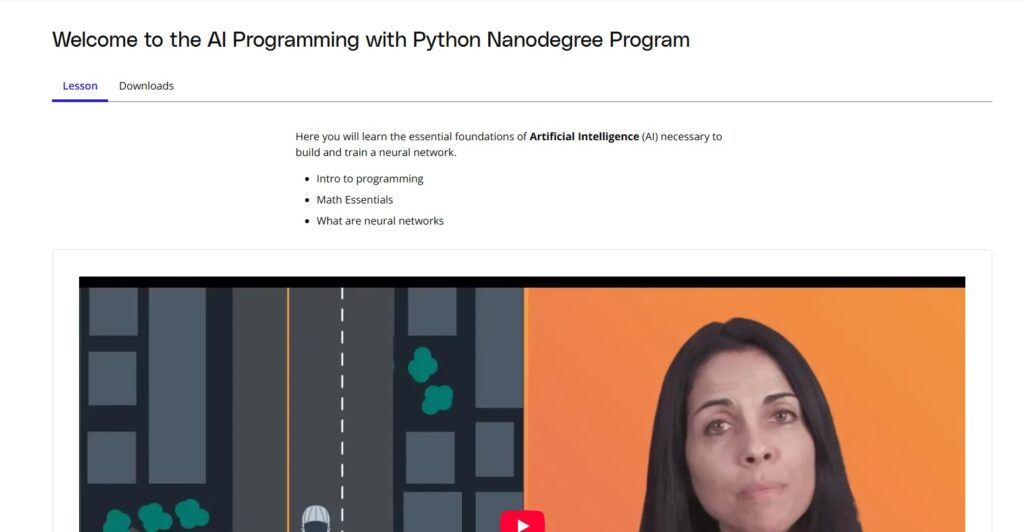
In this post, I’ll walk you through everything you need to know about the program —
- what’s inside the curriculum
- what kind of hands-on projects you’ll work on
- the things I liked (and the things I didn’t)
- and most importantly, if it’s actually worth your time and money
Now, without further ado, let’s get started and see Udacity AI Programming With Python Review-
Udacity AI Programming With Python Review
What Is This Nanodegree All About?
When I first joined the Udacity AI Programming with Python Nanodegree, I was looking for something that could help me build a strong foundation in AI. I didn’t have expert-level math or coding skills at the time, so I needed a course that could guide me step by step.
This program is made for beginners like us. It covers the basics you really need to get started in AI, such as:
- Python programming — learning how to write code in Python in a clear and simple way
- Math concepts like linear algebra and calculus — explained in a way that makes sense even if you’re not from a math background
- Working with tools like NumPy, Pandas, and Matplotlib — which are used in real-world data projects
- Neural networks using PyTorch — where you get to understand how machines learn
- A bit of transformers and image classification — just enough to spark your interest and get hands-on experience
I found it really helpful because it’s built for people who want to become an AI Engineer, Machine Learning Engineer, or Data Scientist, but may not have strong programming or math skills yet.
If you’re starting from scratch like I was, this course gives you the right push in the right direction.
Who Is This Course For?
When I first looked for courses, I wanted something that fit my level and goals. This Nanodegree worked well for me, and I think it’s a great fit if:
- You’re new to AI or machine learning and want to start learning from the beginning.
- You already know some basic Python and remember high-school level algebra.
- You like learning by doing — with real projects that help you practice what you’ve learned.
- You’re thinking about changing your career and want a clear, step-by-step program to follow.
If any of this sounds like you, this course could be a great place to start your AI journey.
A Closer Look at the Course Structure
Let me take you through what you’ll actually learn in each part of the course, step by step.
Course 1: Introduction to AI Programming
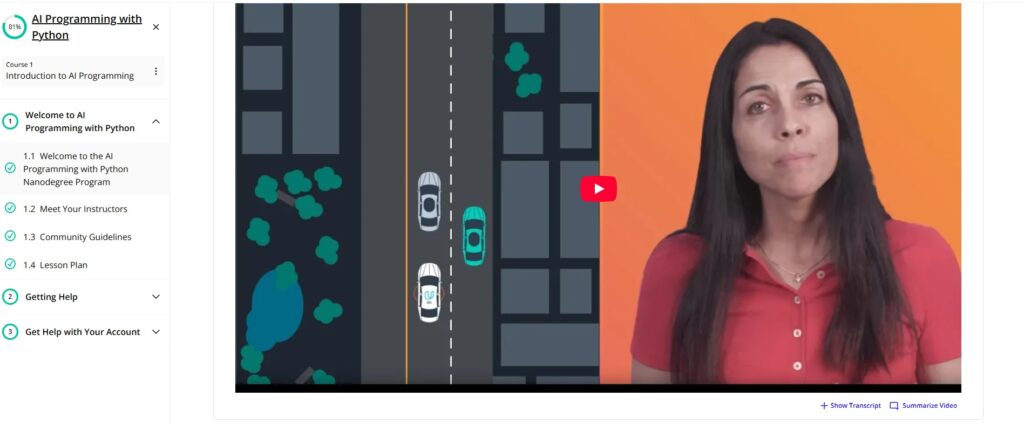
This was my first step into AI programming with Python. It felt like a nice, friendly welcome to the world of AI, even though I was just starting out.
This is what I went through in the first few lessons:
- Welcome to AI Programming with Python
This lesson gave me a clear idea of what the course is about and what to expect next. It helped me feel ready to start. - Getting Help
Starting something new can feel tricky, so this part explained how I could get help with the projects or any questions I had. It was good to know support was there when I needed it. - Get Help with Your Account
If you have any problems with your account or questions about the course itself, this lesson shows you where to go and what to do.
Course 2: Introduction to Python for AI Programmers
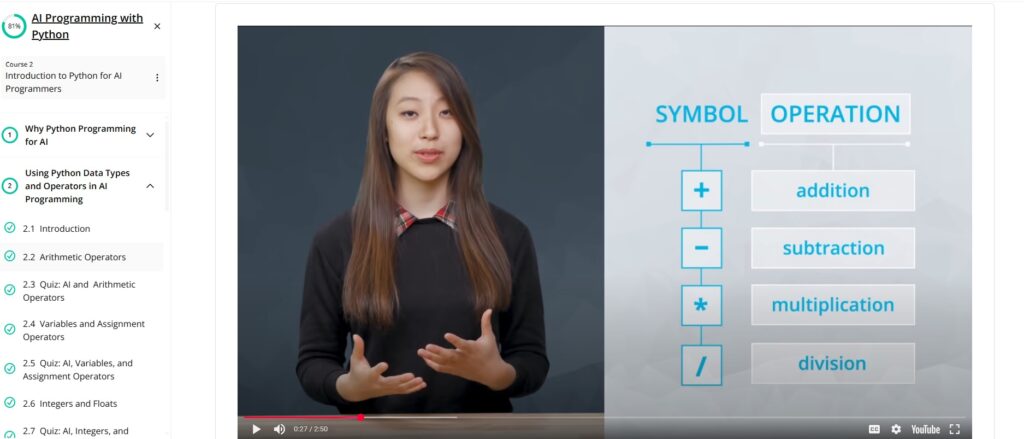
This part of the course really helped me start coding with Python. I learned how to use Python libraries and write simple scripts that can solve tricky problems faster.
One of the coolest parts was the project where I used a pre-trained image classifier to recognize different dog breeds. It made the learning feel real and fun.
This is a quick look at what you’ll learn in the lessons:
- Why Python Programming for AI
This lesson gives a nice overview of why Python is so important for AI. It helped me understand why I should focus on learning Python first. - Using Python Data Types and Operators in AI Programming
I got familiar with the basics here — like different data types, operators, and how to use built-in functions. It also taught me some simple rules on how to write clean code. - Python Data Structures in AI Programming
This lesson showed me how to organize data using lists, dictionaries, and other data structures. It made working with data much easier. - Using Control Flow in AI Programming
Here, I learned how to add logic to my code. Things like if-else statements, loops, and list comprehensions made my programs smarter. - Using Python Functions in AI Programming
Functions are super useful, and this lesson taught me how to write my own functions, reuse code, and even work with more advanced things like lambda expressions. - Python Scripting for AI Programming
This helped me set up my coding environment and write Python scripts on my own computer. I also learned some good habits for scripting and tools that make life easier. - Introduction to Object-Oriented Python for AI Programming
I got introduced to object-oriented programming here. It’s a different way to organize code, and it helped me build my own Python package. - Project: Use a Pre-trained Image Classifier to Identify Dog Breeds
For the project, I used what I learned to write Python code that runs an image classifier to identify dog breeds. It was exciting to see it work!
Course 3: NumPy, Pandas, and Matplotlib
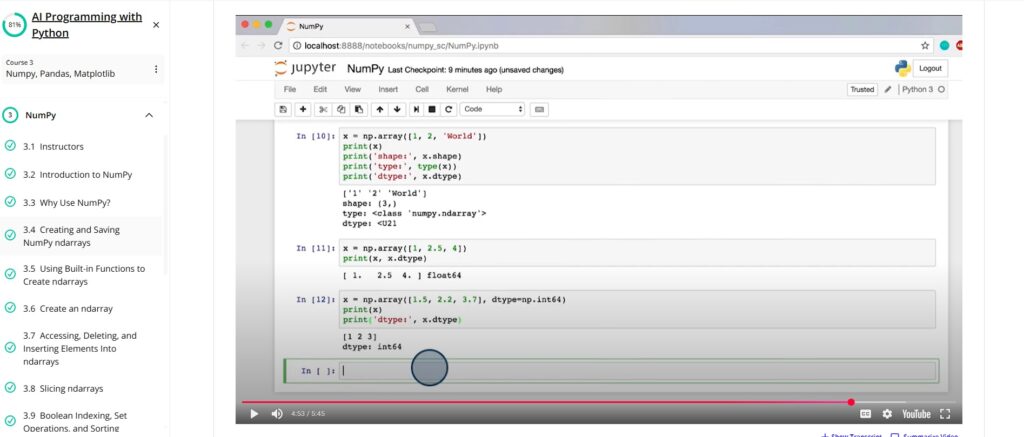
This course was all about some really important Python libraries that helped me handle and understand data better. I learned to work with NumPy for big data, Pandas for organizing and analyzing data, and Matplotlib for making graphs and charts to see what the data is telling us.
This is a quick look at what I covered in each lesson:
- Anaconda
I learned how to use Anaconda, which is a tool that helps you manage your Python packages and environments. It made my data analysis work much smoother. - Jupyter Notebooks
Jupyter Notebooks were my go-to for writing Python code while learning. They’re great for experimenting and sharing what you find, especially when you want to show your data visualizations. - NumPy
This lesson taught me the basics of NumPy and how to create and work with arrays, which are like lists but way faster and better for large data. - Pandas
With Pandas, I learned how to load data, organize it, and work with Series and DataFrames — which are super helpful for data manipulation and analysis. - Matplotlib and Seaborn Part 1
Here, I started making my own charts using Matplotlib and Seaborn to show how single variables are distributed in my data. - Matplotlib and Seaborn Part 2
Next, I learned how to create charts that show the relationships between two variables. It helped me find connections in the data that I wouldn’t see otherwise.
Course 4: Linear Algebra Essentials
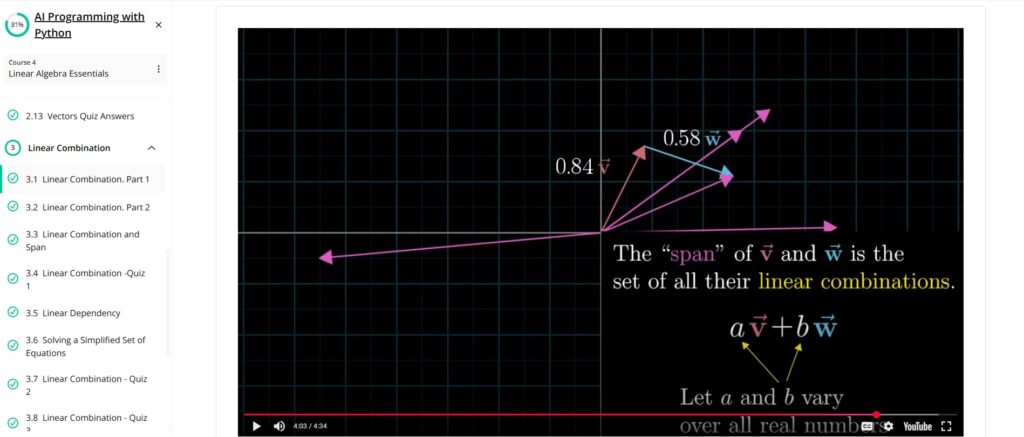
This course introduced me to the basics of linear algebra, which is a really important math tool in AI. At first, it sounded a bit intimidating, but the way it was explained made it feel interesting and doable.
This is what I learned in each lesson:
- Introduction
I got a quick overview of linear algebra and why it matters so much in AI. It helped me see the bigger picture before diving into the details. - Vectors
This lesson was all about vectors — the building blocks of linear algebra. I learned what they are and why they’re so important. - Linear Combination
Here, I learned how to scale and add vectors together, plus how to picture what’s going on. It made the math feel more real. - Linear Transformation and Matrices
This was about linear transformations and how they relate to matrices. I got to see how these ideas connect and how to use them in practice. - Vectors Lab
In this hands-on part, I learned how to graph vectors in 2D, which made it easier to understand what they represent. - Linear Combination Lab
I practiced finding the span of a vector and solving simple systems of equations using what I’d learned. - Linear Mapping Lab
This lesson showed me how to solve problems using vectors and matrices with code, which helped bring everything together. - Linear Algebra in Neural Networks
At the end, I got a peek into how linear algebra plays a role in neural networks — it was cool to see the connection to AI in action.
Course 5: Calculus Essentials

This course helped me get comfortable with the basics of calculus, which is really important when you start working with neural networks. At first, some of the ideas seemed tricky, but the way they explained things made it much easier to follow.
This is what I learned:
- Calculus
I learned the foundation of calculus — things like plotting functions, understanding derivatives, and the chain rule. These are the building blocks you need to know. - Calculus in Neural Networks
Then, I saw how these calculus concepts actually work when training a neural network. It was really helpful to see the math come to life with a clear example.
Course 6: Neural Networks – AI Programming with Python
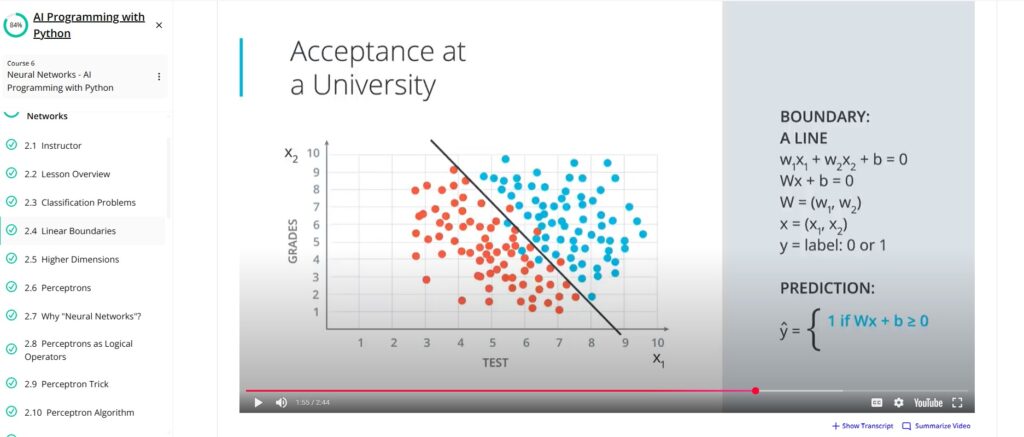
This course was all about understanding neural networks — the algorithms inspired by how our brain works. It helped me see how these ideas come together to solve real problems by designing neural networks.
This is what I learned step by step:
- Welcome to Neural Networks
The course started with a warm welcome and a clear introduction to what neural networks are all about. - Introduction to Neural Networks
Luis explained the basics of deep learning and neural networks in a way that made it easy to understand. I even got to try out gradient descent and backpropagation in Python right in the lessons. - Implementing Gradient Descent
Mat showed me a new error function and guided me through coding gradient descent using NumPy matrix multiplication — which was a great way to see the math in action. - Training Neural Networks
After learning what neural networks do, I discovered different techniques to train them better and get good results. - Deep Learning with PyTorch
Finally, I learned how to use PyTorch, a popular tool, to build deep learning models and take my skills further.
Course 7: Programming Transformer Neural Networks with PyTorch
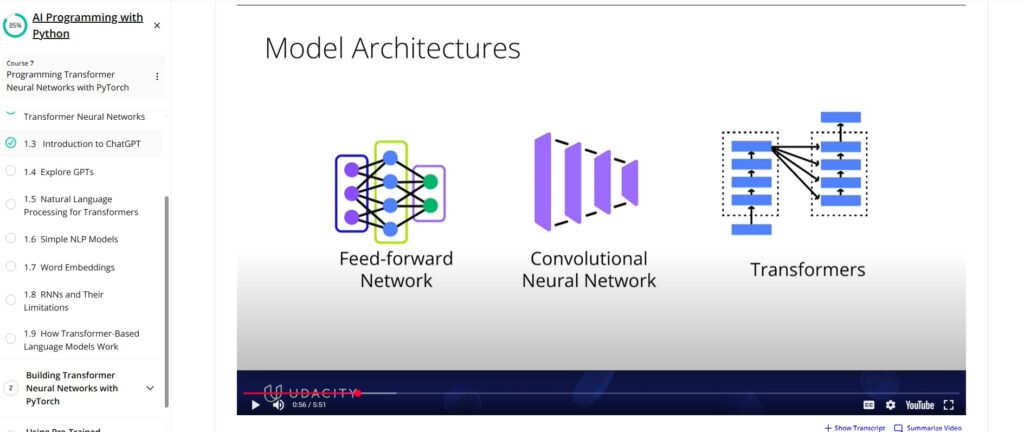
This course introduced me to Transformer Neural Networks, which are really powerful models behind things like ChatGPT. It showed me how to build and train these models using PyTorch, starting from the basics and moving toward more advanced ideas.
This is what I learned along the way:
- Introduction to Transformer Neural Networks
I got to explore how Transformer networks work, their structure, and some cool uses like natural language processing (NLP). I also learned about tokenization and how to train these models with PyTorch. - Building Transformer Neural Networks with PyTorch
In this part, I learned how to actually build a Transformer model step-by-step. This included important concepts like tokenization, embeddings, multi-head attention, and generating text for NLP tasks. - Using Pre-Trained Transformers
Finally, I learned how to work with pre-trained Transformer models — how they’re trained, how to fine-tune them for specific tasks, and their strengths and limitations. This was really useful for applying Transformers to things like text generation and question answering.
Course 8: Create Your Own Image Classifier
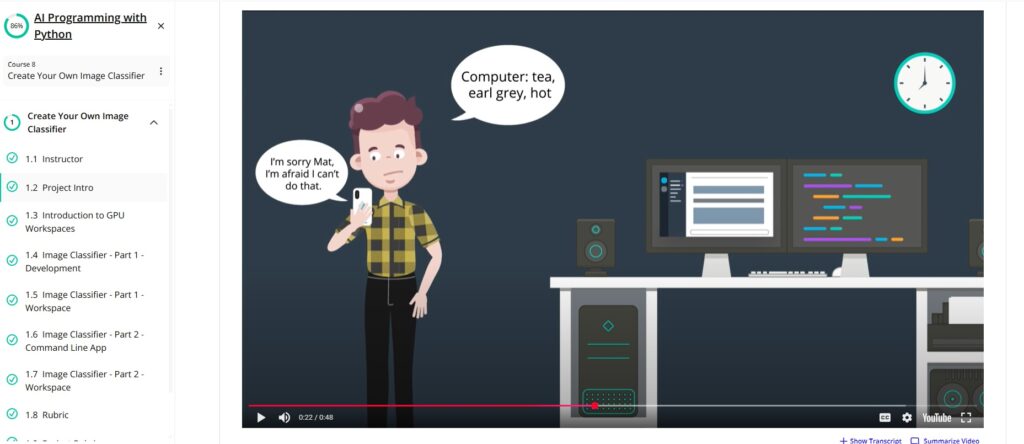
This was the final project of the course, and it was one of the most exciting parts for me. Here, I got to build a modern image classification app from scratch.
The project involved creating a Python program that trains an image classifier using a dataset. After training, the app can look at new images and predict what they are. It was a great way to put everything I learned into practice and see real results.
Course 9: Next Steps!
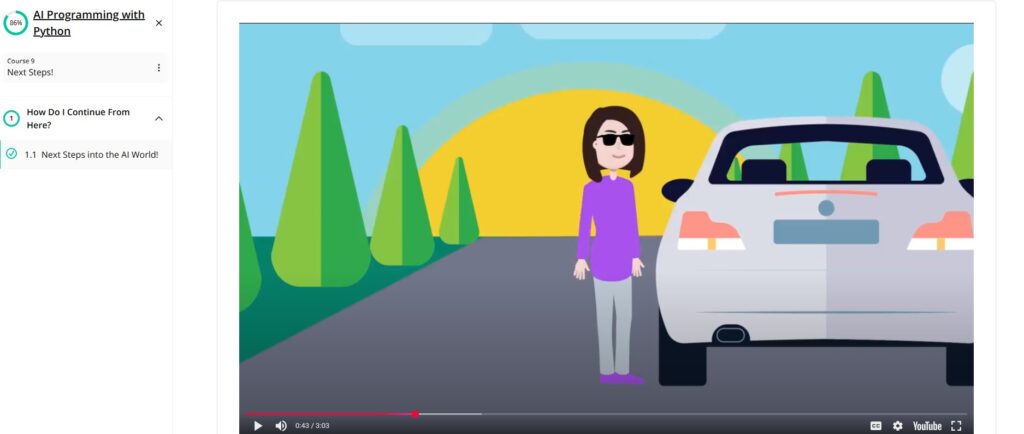
Congratulations! You’ve finished your first nanodegree in the School of AI — that’s a big achievement. Now, you might be wondering what to do next.
This lesson helped me figure out the best way to keep moving forward with my AI journey and what steps I could take to build on what I just learned.
Course 10 (Optional): Git and GitHub
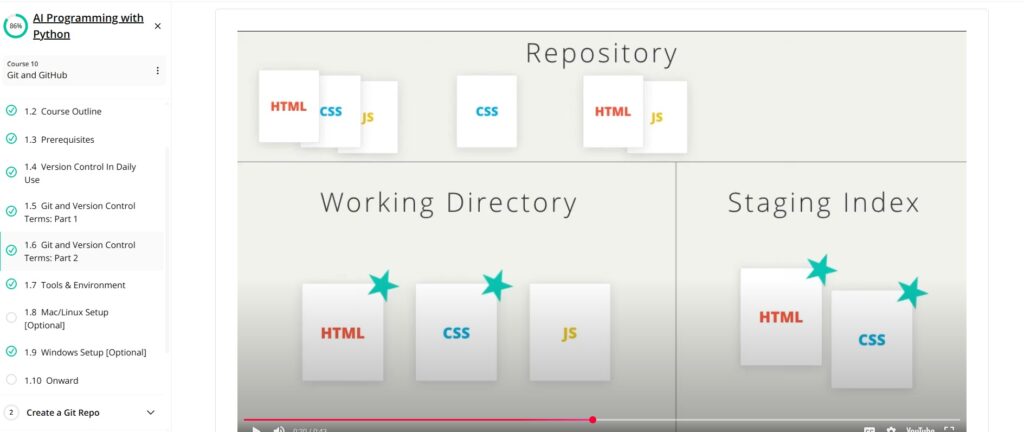
When I started programming seriously, I realized how important it is to keep track of changes in your code. That’s where version control comes in, and Git is one of the most popular tools for this.
In this optional course, I learned how to use Git to manage my code versions and how to work with other programmers using GitHub.
The lessons covered important basics like:
- What version control is and why it matters
- How to create a Git repository to save your projects
- Understanding commits, tags, and handling conflicts in code
- How to fork someone else’s project and contribute to it
- Writing good README files to explain your projects clearly
This course was really helpful for me to get comfortable with professional coding practices and teamwork.
Course 11 (Optional): Intro to Machine Learning
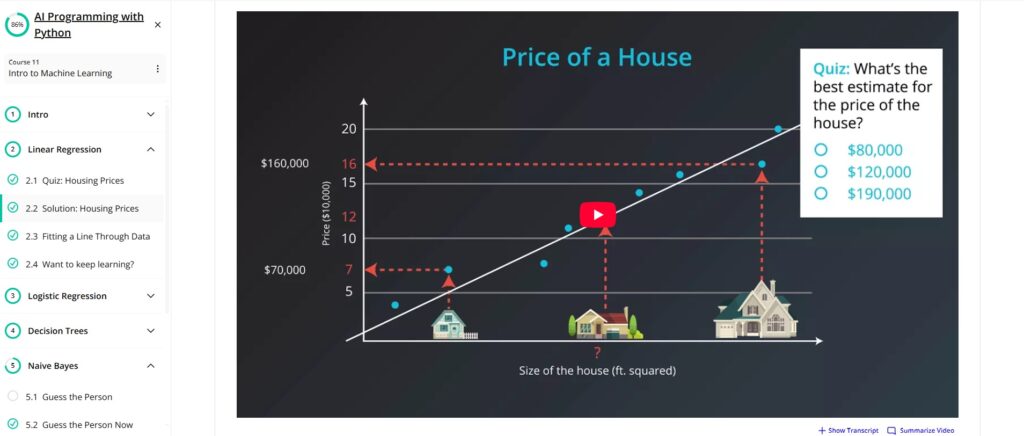
When I went through this course, it gave me a basic understanding of machine learning concepts, but some parts felt a bit rushed or too simple.
This is what I covered:
- A straightforward introduction to machine learning
- How linear regression works for predicting numbers — pretty clear, but quite basic
- Logistic regression explained well, though it felt like an overview rather than deep learning
- Decision trees and how they help with making choices in data — useful, but examples could be stronger
- Naive Bayes classifiers — good introduction, but I wanted more real-world applications
- Support vector machines — interesting concept but somewhat hard to follow without prior math background
- Ensemble methods like bagging and boosting — explained clearly, but some practical examples were missing
- A recap at the end to summarize everything
Overall, the course is a decent starting point if you’re new to machine learning, but it might feel too light if you’re looking for deeper insights or more hands-on practice.
Course 12 (Optional): Learning Rate
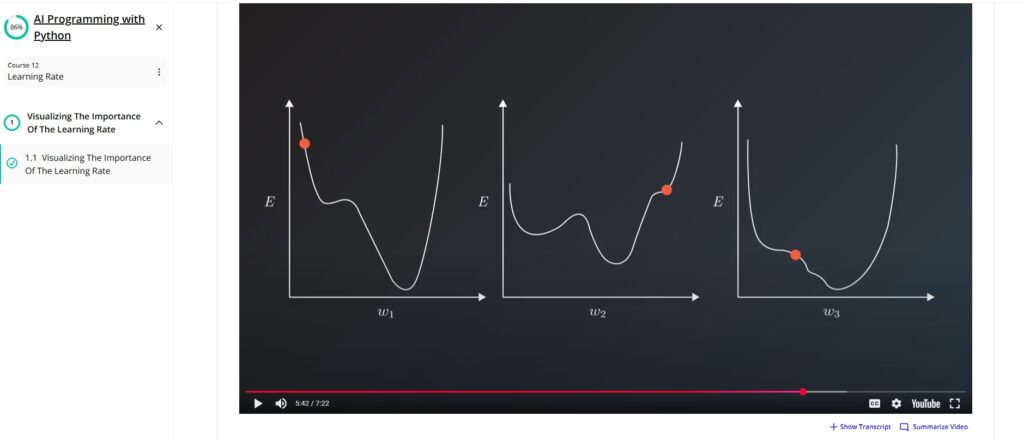
If you’ve ever wondered why the learning rate matters so much in training models, this short course dives into that. It shows how the learning rate affects how quickly or accurately a model learns.
- You’ll get a visual explanation of why the learning rate is important.
It’s a quick course, so don’t expect a deep dive — but it’s helpful if you want to understand this one piece of the puzzle better.
Real Projects You’ll Work On
The projects are what really make this program come alive:
- Identify Dog Breeds Using Pre-trained Models
- Build Your Own Image Classifier
- Create a Transformer NLP Model with PyTorch
What I liked most was getting detailed feedback from reviewers on every project. It really helped me when I got stuck or wasn’t sure if I was on the right track.
Skills You’ll Master
- Writing Python scripts
- Using NumPy, Pandas, and Matplotlib
- Understanding Linear Algebra and Calculus basics
- Building Neural Networks
- Working with Transformers using PyTorch
- Learning the basics of Git and GitHub
- Navigating Jupyter Notebooks and other coding environments
This course gives you a solid path from beginner to intermediate level for anyone interested in AI.
Time Commitment & Duration
The whole program usually takes around 3 to 4 months to complete if you spend about 10 hours each week on it. This time includes watching lessons, practicing coding, and working on projects.
You can take more time if you have a busy schedule or want to go slower to fully understand each topic. On the other hand, if you have more time and focus, you could finish it faster.
The projects unlock one after another, which helps you learn step-by-step and build your skills gradually without getting overwhelmed. This structure keeps the learning organized and makes sure you’re ready for each new challenge as you go.
Pricing & Support
The course costs about $399 per month, but keep an eye out for discounts that can make it more affordable.
Sometimes, Udacity also offers scholarships, especially for underrepresented groups, so it’s worth checking if you qualify.
When you join, you’ll get support from technical mentors who can help with questions, access to student forums where you can connect with others, and career services to help you move forward after the course.
What I Really Liked
The course takes you step-by-step, starting with Python and building up to deep learning, which made it easy to follow. The math topics were explained with visuals, so they didn’t feel so intimidating. I also appreciated how PyTorch was taught from the basics all the way to practical use.
The projects felt relevant to real-world problems, and getting feedback on them was super helpful when I got stuck. Plus, the course even introduced advanced topics like Transformers—something you don’t usually find in beginner-level courses.
What Could Be Improved
One thing to keep in mind is the monthly cost, which can add up if you don’t finish the course quickly. Also, while the course says you just need basic Python knowledge, I found it helpful to brush up on some Python basics again before starting.
Another thing is the math sections — I wish there were more hands-on notebooks or exercises to practice alongside the lessons. That would make understanding the concepts easier.
Is It Worth It?
Yes, if:
- You’re serious about starting a career in AI or machine learning.
- You want to learn Python along with the essential math needed for AI.
- You like learning by doing projects and getting feedback.
- You’re planning to dive deeper later with more advanced courses like Udacity’s ML or Deep Learning Nanodegrees.
Maybe not, if:
- You already feel confident with Python, NumPy, and linear algebra.
- You’re looking for free options—you might want to check out Coursera or edX instead.
My Advice
If you’re starting out in AI, building a solid foundation is key. This Nanodegree offers a clear structure with important math concepts and practical tools, which can definitely help you get started.
However, don’t rely on just one program. Supplement your learning with free resources like Coursera, edX, or YouTube tutorials, especially for areas like Python basics or advanced math. Practice coding regularly on platforms like Kaggle or GitHub to apply what you learn.
Also, join online communities or forums to ask questions and get feedback — learning from others can accelerate your progress.
Most importantly, be patient and consistent. If you can dedicate 10–12 hours a week, this path is a solid way to build your AI skills while exploring other resources alongside it.
Conclusion
Overall, this Udacity AI Programming With Python Review shows that the program offers a clear, structured path for beginners to dive into AI programming. It covers essential math, Python skills, and practical projects, making it a solid choice for those starting out.
However, as highlighted in this Udacity AI Programming With Python Review, no single course is a silver bullet. Complementing the Nanodegree with additional practice and resources will help deepen your understanding and skills.
If you’re serious about learning AI, this Udacity AI Programming With Python Review suggests the program is a valuable foundation—but be prepared to keep exploring beyond it.
For anyone considering their first AI course, this Udacity AI Programming With Python Review offers an honest look at what to expect, helping you decide if it fits your learning style and goals.
In short, this Udacity AI Programming With Python Review recommends the Nanodegree as a meaningful step—especially if you’re ready to commit time and effort to build a strong AI programming foundation.
You May Also Be Interested In
Best Resources to Learn Computer Vision (YouTube, Tutorials, Courses, Books, etc.)- 2026
Best Certification Courses for Artificial Intelligence- Beginner to Advanced
Best Natural Language Processing Courses Online to Become an Expert
Best Artificial Intelligence Courses for Healthcare You Should Know in 2026
What is Natural Language Processing? A Complete and Easy Guide
Best Books for Natural Language Processing You Should Read
Augmented Reality Vs Virtual Reality, Differences You Need To Know!
What are Artificial Intelligence Examples? Real-World Examples
Thank YOU!
Explore more about Artificial Intelligence.
Though of the Day…
‘ It’s what you learn after you know it all that counts.’
– John Wooden
Written By Aqsa Zafar
Aqsa Zafar is a Ph.D. scholar in Machine Learning at Dayananda Sagar University, specializing in Natural Language Processing and Deep Learning. She has published research in AI applications for mental health and actively shares insights on data science, machine learning, and generative AI through MLTUT. With a strong background in computer science (B.Tech and M.Tech), Aqsa combines academic expertise with practical experience to help learners and professionals understand and apply AI in real-world scenarios.

